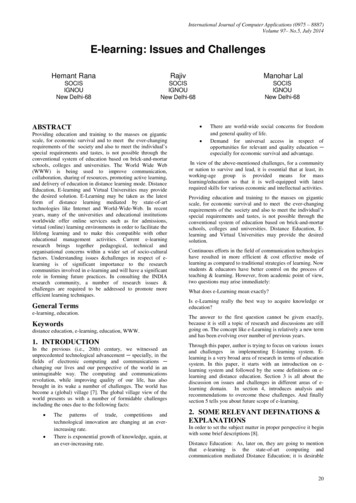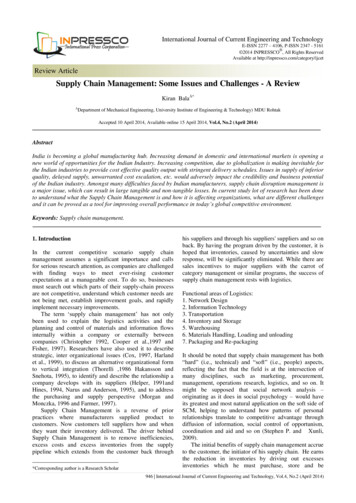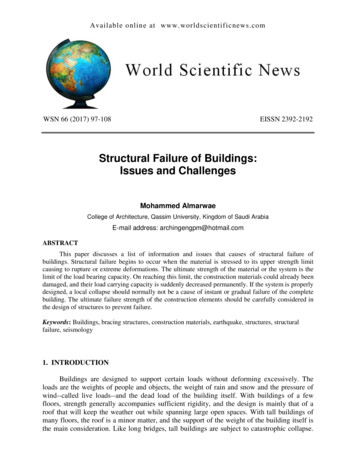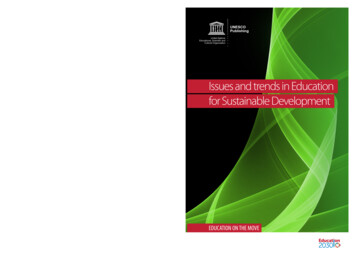
Transcription
International Journal of Computer Applications (0975 – 8887)Volume 97– No.5, July 2014E-learning: Issues and ChallengesHemant RanaRajivManohar LalSOCISIGNOUNew Delhi-68SOCISIGNOUNew Delhi-68SOCISIGNOUNew Delhi-68ABSTRACTProviding education and training to the masses on giganticscale, for economic survival and to meet the ever-changingrequirements of the society and also to meet the individual’sspecial requirements and tastes, is not possible through theconventional system of education based on brick-and-mortarschools, colleges and universities. The World Wide Web(WWW) is being used to improve communication,collaboration, sharing of resources, promoting active learning,and delivery of education in distance learning mode. DistanceEducation, E-learning and Virtual Universities may providethe desired solution. E-Learning may be taken as the latestform of distance learning mediated by state-of-arttechnologies like Internet and World-Wide-Web. In recentyears, many of the universities and educational institutionsworldwide offer online services such as for admissions,virtual (online) learning environments in order to facilitate thelifelong learning and to make this compatible with othereducational management activities. Current e-learningresearch brings together pedagogical, technical andorganisational concerns within a wider set of socio-culturalfactors. Understanding issues &challenges in respect of elearning is of significant importance to the researchcommunities involved in e-learning and will have a significantrole in forming future practices. In consulting the INDIAresearch community, a number of research issues &challenges are required to be addressed to promote moreefficient learning techniques.General Termse-learning, education.Keywordsdistance education, e-learning, education, WWW.1. INTRODUCTIONIn the previous (i.e., 20th) century, we witnessed anunprecedented technological advancement specially, in thefields of electronic computing and communications changing our lives and our perspective of the world in anunimaginable way. The computing and communicationsrevolution, while improving quality of our life, has alsobrought in its wake a number of challenges. The world hasbecome a (global) village [7]. The global village view of theworld presents us with a number of formidable challengesincluding the ones due to the following facts: The patterns of trade, competitions andtechnological innovation are changing at an everincreasing rate.There is exponential growth of knowledge, again, atan ever-increasing rate. There are world-wide social concerns for freedomand general quality of life.Demand for universal access in respect ofopportunities for relevant and quality education especially for economic survival and advantage.In view of the above-mentioned challenges, for a communityor nation to survive and lead, it is essential that at least, itsworking-age group is provided means for masslearning/education so that it is well-equipped with latestrequired skills for various economic and intellectual activities.Providing education and training to the masses on giganticscale, for economic survival and to meet the ever-changingrequirements of the society and also to meet the individual’sspecial requirements and tastes, is not possible through theconventional system of education based on brick-and-mortarschools, colleges and universities. Distance Education, Elearning and Virtual Universities may provide the desiredsolution.Continuous efforts in the field of communication technologieshave resulted in more efficient & cost effective mode oflearning as compared to traditional strategies of learning. Nowstudents & educators have better control on the process ofteaching & learning. However, from academic point of view,two questions may arise immediately:What does e-Learning mean exactly?Is e-Learning really the best way to acquire knowledge oreducation?The answer to the first question cannot be given exactly,because it is still a topic of research and discussions are stillgoing on. The concept like e-Learning is relatively a new termand has been evolving over number of previous years.Through this paper, author is trying to focus on various issuesand challenges in implementing E-learning system. Elearning is a very broad area of research in terms of educationsystem. In this paper, it starts with an introduction on elearning system and followed by the some definitions on elearning and distance education. Section 3 is all about thediscussion on issues and challenges in different areas of elearning domain. In section 4, introduces analysis andrecommendations to overcome these challenges. And finallysection 5 tells you about future scope of e-learning.2. SOME RELEVANT DEFINATIONS &EXPLANATIONSIn order to set the subject matter in proper perspective it beginwith some brief descriptions [8].Distance Education: As, later on, they are going to mentionthat e-learning is the state-of-art computing andcommunication mediated Distance Education; it is desirable20
International Journal of Computer Applications (0975 – 8887)Volume 97– No.5, July 2014to enumerate the characteristic features of Distance Education,which are identified by Keegan (1980) [1] , one of thepioneers in the discipline, as follows: The separation of learner and teacherInfluence of an educational organizationThe use of media as a medium between a teacherand a learner(like, TV, RADIO etc )Facilitate two-way exchange of informationLearners as an individual rather than in group; andEducators as an industrialized formE-Learning: Rosenberg (2001) [2] Defines the term elearning as, the use of Internet technologies to deliver a broadarray of solutions that enhance knowledge and performance”.e-learning is based on three fundamental criteria suggested byRosenberg [2]: Networked for instant updating, distribution,storage/retrieval and sharing of information.Content delivery via computer using WWW.It focuses on the broadest view of learning andlearning solutions.Thus, e-Learning may be taken as the latest form of distancelearning mediated by state-of-art technologies like Internetand World-Wide-Web. They must remember that e-Learningis much more than online training or Computer-BasedTraining (CBT), encompassing knowledge management andelectronic performance support, Computer –conferencingenabling group communication, enabled by Internet andWWW is one the key characteristics of e-learning whichmakes it qualitatively much superior to the conventionaldistance learning paradigm [2], [4] , [5].of resources, promoting active learning, and delivery ofeducation in distance learning mode[6][16]. The WWW helpsteachers in planning suitable online delivery structure, sharinggoals of learning, and activities for their courses.In recent years, many of the universities and educationalinstitutions worldwide offer online services such as foradmissions, virtual (online) learning environments in order tofacilitate the lifelong learning and to make this compatiblewith other educational management activities[9]. Forexample, a teacher may create a purely Web-based deliverysystem including online handouts in respect of student’sactivities, projects and lists of resources for reference. Thestudents and other learners may access web-based materialanytime from anywhere in the world, being connected throughInternet[15].3. ISSUES & CHALLENGES IN ELEARNING3.1 Technological ChallengesThe e-learning raises significant challenges in thetechnological research area. For development of e-learningresources that meet the users requirement need to beaddressed. The technological challenges of e-learning can beconsidered as a two key technological research areas.3.2 Development of New Forms ofLearning community and InteractiveLearningIn e-learning environments interaction, cooperation andcommunity play an important role to support learning. Thedevelopments in the area of e-learning environments providenew forms of interaction for learning experience. It generatesnew relationships between learner and computer and alsoform a new learning community. Key issues include:Longmire (2001) states “e-Learning covers a wide set ofapplications and processes such as computer-based learningsystems, Web-based learning systems, virtual classrooms, anddigital collaborative learning GroupWare packages. ELearning content is mainly delivered via Internet,intranet/extranet, audiotape and videotape; satellite broadcast,interactive TV, DVD and CD-ROM, and the still to emergewireless application protocols (WAP) “[3 ]. Computer - based conferencing that enables groupcommunication, and is itself enabled by Internet and WWW is one of the key characteristic of e-Learning which makes itqualitatively much superior to the conventional distancelearning paradigm. Key attributes of e-Learning, as subsumed by the abovedefinition, may be explicitly stated as: Many-to-many (i.e. group) communicationAny place (place independence)Any time (asynchronicity, time independence)Text, enhanced by multi-media andComputer-conferencing (i.e., computer mediatedmessaging)In order to facilitate learning & education, web is being usedas the backbone and we cannot underestimate its value indelivery and promoting effective learning to the people.For about last two decades, the World Wide Web(WWW) isbeing used to improve communication, collaboration, sharing New forms of multimodal interface to supportlearning.New techniques to understand and support learningcommunities.The development of systems to support mobilecommunities of learners.Personalisation techniques that meet user personalneeds and current activity.Techniques to promote and support interaction.Discovery of new learning communities.Support for time to time assessment services.3.3 Developing New Knowledge Facilitiesfor e-learninge-learning environment needs to support the rapid increase inthe size and variety of data by appropriate semantic services.The semantic services generate a surrounding semanticcontext for learning support. Research that needs to work on: Development of learning and reasoning theories foruncertain and incomplete knowledge.Support for the development of large-scale learningfacilities.Support for a dynamic learning process.Support for information sharing across differentlearning facilities.Developments of lightweight knowledge capturetechnique for promotion of lifelong learning.21
International Journal of Computer Applications (0975 – 8887)Volume 97– No.5, July 2014 Development of learning support services as per therequirement of different domains and users.3.4 Research Issues for e-learningCurrent e-learning research brings together pedagogical,technical and organisational concerns within a wider set ofsocio-cultural factors. These factors influence the researchagenda in e-learning system. Understanding these broadersocial and cultural issues is of significant importance to theresearch communities involved in e-learning and will have asignificant role in informing future practices. In consulting theINDIA research community, a number of research issuesemerged:Interdisciplinary, and the notion of multiple voices, is adefining characteristic of the area. How do different researchperspectives influence the overall area? How do problems inthe practice of different disciplines differ in the adoption anduse of learning technologies?sets, fuzzy sets, neural networks, machine learning etc) can beintegrated with the e-learning applications to supportintelligence [10].In support of e-learning on the web, a new version of WorldWide Web called Web 3.0 has been proposed as a possiblefuture consisting of the integration of high-powered graphics(Scalable Vector Graphics or SVG) and semantic data. Therehave also been discussions around 3-D social networkingsystems and immersive 3-D internet environments that willtake the best of virtual worlds (such as Second Life) andgaming environments and merge them with the Web. Web 3.0based e-learning services will be having constructive impacton education. Web 3.0 technologies offer benefits of 3Dwikis, 3D Labs; Intelligent Agent based search engines,Virtual environments like Avatar, Semantic Digital Librariesthat may result in added advantage in delivery of effective elearning to the mass [9][13].Access and inclusion, includes issues around the wideningparticipation agenda. What are the barriers to inclusion andwhat are the issues surrounding the extent of the digitaldivide?Change, and its relationship to learning technologies. Howdoes change impact upon motivational issues? What are thedrivers and rationales for change? What are appropriatestrategies for managing changes and mechanisms for theirimplementation?Convergence and interoperability, in terms of explorationof different forms of convergence (organisational,technological, pedagogical, sectoral, institutional, etc). Howwell do they understand issues of globalisation and scalabilitystandards to support interoperability? These are complexrelationships. A current focus is also on standardisation acrossthe pedagogical, technical, organisational and human aspectsversus critique of convergence.Interactivity and social interaction: How does theinteractivity of different tools relate to, or impact upon, thenature of the medium? How is interactivity expressed atdifferent levels of organisations, and how have organisationalboundaries and functional groupings blurred as a consequenceof new technologies? What potential do the new technologieshave to enhance communication and collaboration and alsocreating new communities and networks?4. ANALYSIS & RECOMMENDATIONSAccording to the study, learning contents and learningcommunities got the highest priority in e-learning research. Inthese areas, lots of development has to be made. Astechnology is growing day by day, learner interest in elearning increases very rapidly. Now researcher has begun towork on the designing new e-learning methodologies that canwork accord
International Journal of Computer Applications . Rajiv SOCIS IGNOU New Delhi-68 Manohar Lal SOCIS IGNOU New Delhi-68 ABSTRACT Providing education and training to the masses on gigantic scale, for economic survival and to meet the ever-changing requirements of the society and also to meet the individual’s special requirements and tastes, is not possible through the conventional system of .











